Recurrence of Sub-Synchronous Oscillation Accident of Hornsea Wind Farm in UK and Its Suppression Strategy
Abstract
:1. Introduction
2. Introduction of Hornsea Wind Farm Accident
2.1. Hornsea Wind Farm
2.2. Development of Accidents
2.3. Causes of the Accident
3. Solutions
4. Verification Based on Simulation
4.1. Simulation Model
4.2. Recurrence of Accident
- During the simulation time of 3.490–3.590 s, within the AB interval, the maximum drop of the 35 kV bus voltage of the Hornsea wind farm is approximately 4%. This corresponds to a 5% drop in the voltage of the 35 kV bus within 16:52:33:490–16:52:33:600.
- During the simulation time of 3.590–3.695 s, within the BC interval, the voltage of the 35 kV bus of the wind farm drops nearly 35%, and the wind turbine enters the low voltage traversal mode. The active power output of Hornsea 1B drops to about 200 MW and then recovers. It corresponds to that at 16:52:33:600–16:52:33:728, when the active power output of the wind turbine was reduced by about half and then restored.
- During the simulation time of 3.695–3.715 s, within the CD interval, all wind turbine generators on Hornsea 1B reduce to 0 MW as a result of overcurrent protection in the generators. This corresponds to the disconnection of the wind turbines at 16:52:33:728.
4.3. Verify the Effectiveness of the Proposed Strategy
- Terminal voltage of wind turbines
- 2.
- Active power output of Hornsea 1B
- 3.
- Reactive power output of Hornsea 1B
- 4.
- DC bus voltage
5. Conclusions
- The accident response of a sub-synchronous oscillation event in the Hornsea wind power system is mimicked in MATLAB simulation according to the information provided in British official reports. It is verified that the simulation results are consistent with the actual accident reaction results. It provides a good basis for analyzing the causes of the accident and putting forward specific and feasible solutions.
- The control of the grid-side converter is improved to deal with the sub-synchronous oscillation event caused by asymmetric voltage drop fault in the Hornsea wind power system. It was found that while maintaining the stability of the DC bus voltage, increasing the control of the positive sequence component of terminal voltage and compensating the reactive power will recover the voltage quickly.
- The validity of the proposed control strategy to suppress the sub-synchronous oscillation of offshore wind power system is verified by simulation. The simulation results show that the strategy can control the fast and appropriate output of reactive power from the DFIG to the power grid, reduce the voltage oscillation amplitude of the power grid, weaken the influence of system failure on the Hornsea wind farm, smooth the power output of the DFIG, and suppress the sub-synchronous oscillation of the Hornsea wind power system.
Author Contributions
Funding
Institutional Review Board Statement
Informed Consent Statement
Data Availability Statement
Acknowledgments
Conflicts of Interest
References
- National Grid ESO. Technical Report on the Events of 9 August 2019[EB/OL]. Available online: https://www.nationalgrideso.com/document/152346/download (accessed on 6 September 2019).
- National Grid ESO. Appendices to the Technical Report on the Events of 9 August 2019 [EB/OL]. Available online: https://www.ofgem.gov.uk/system/files/docs/2019/09/eso_technical_report_-_appendices_-_final.pdf (accessed on 6 September 2019).
- National Grid ESO. Interim Report into the Low Frequency Demand Disconnection (LFDD) following Generator Trips and Frequency Excursion on 9 August 2019[EB/OL]. Available online: https://www.ofgem.gov.uk/system/files/docs/2020/07/national_grid_eso_report_lfdd_9_august_2019.pdf (accessed on 6 September 2019).
- Fang, Y. Reflections on Frequency Stability Control Technology Based on the Blackout Event of 9 August 2019 in UK. Autom. Electr. Power Syst. 2019, 43, 1–5. [Google Scholar]
- Sun, H.; Xu, T.; Guo, Q.; Li, Y.; Lin, W.; Yi, J.; Li, W. Analysis on blackout in great britain power grid on august 9th,2019 and its enlightenment to power grid in China. Proc. CSEE 2019, 39, 6183–6192. [Google Scholar]
- Dian, Y. Analysis of the UK’s blackouts: A large replacement of traditional thermal power by new energy sources will lead to a decline in system inertia levels. Electr. Power Equip. Manag. 2019, 9, 98. [Google Scholar]
- Teng, S.; Gong, Y.; Zhang, P.; Li, X. Analysis of great blackout accident in Britain on august 9,2019 and enlightenment to Beijing power network. Electr. Power Surv. Des. 2020, 2, 5–8. [Google Scholar]
- Fan, C.; Yao, J.; Zhang, Q.; Xu, C.; Ren, H. Reflection and Analysis for oscillation of the blackout event of 9 august 2019 in UK. Electr. Power Eng. Technol. 2020, 39, 34–41. [Google Scholar]
- Ei-Moursi, M.S.; Bak-Jensen, B.; Abdel-Rahman, M.H. Novel STATCOM controller for mitigating SSR and damping power system oscillations in a series compensated wind park. IEEE Trans. Power Electro. 2010, 25, 429–441. [Google Scholar] [CrossRef]
- Mohammadpour, H.; Santi, E. SSR damping controller design and optimal placement in rotor-side and grid-side convertors of series compensated DFIG-based wind farm. IEEE Trans. Sustain. Energy 2012, 6, 388–399. [Google Scholar]
- Ning, W.; Wu, X.; Guan, Y.; Chen, F. Method to suppress sub-synchronous oscillation of DFIG-based wind farms based on virtual impedance. J. Eng. 2018, 2017, 2173–2177. [Google Scholar] [CrossRef]
- Mohamed, M.A.; Diab, A.A.Z.; Rezk, H.; Jin, T. A novel adaptive model predictive controller for load frequency control of power systems integrated with DFIG wind turbines. Neural Comput. Appl. 2019, 32, 7171–7181. [Google Scholar] [CrossRef]
- Nian, H.; Xiao, J.; Sciubba, E. Modeling and Analysis of Transient Reactive Power Characteristics of DFIG Considering Crowbar Circuit under Ultra HVDC Commutation Failure. Energies 2021, 14, 2743. [Google Scholar] [CrossRef]
- Wu, X.; Guan, Y.; Yang, X.; Ning, W.; Wang, M. Low-cost control strategy based on reactive power regulation of DFIG-based wind farm for SSO suppression. IET Renew. Power Gener. 2019, 13, 33–39. [Google Scholar] [CrossRef]
- Wu, X.; Guan, Y.; Ning, W. Reactive power control strategy of DFIG-based wind farm to mitigate SSO. J. Eng. 2017, 2017, 1290–1294. [Google Scholar] [CrossRef]
- Wang, Y.; Du, W.; Chen, C.; Zhen, Z.; Wang, H. Investigation on sub-synchronous oscillations in DFIG-based transmission system based on improved complex torque coefficients method. J. Eng. 2019, 2019, 2244–2249. [Google Scholar] [CrossRef]
- Jiao, Y.; Li, F.; Dai, H.; Nian, H. Analysis and Mitigation of Sub-Synchronous Resonance for Doubly Fed Induction Generator under VSG Control. Energies 2020, 13, 1582. [Google Scholar] [CrossRef] [Green Version]
- Din, Z.; Zhang, J.; Bassi, H.; Rawa, M.; Song, Y. Impact of Phase Locked Loop with Different Types and Control Dynamics on Resonance of DFIG System. Energies 2020, 13, 1039. [Google Scholar] [CrossRef] [Green Version]
- Xue, A.; Fu, X.; Wang, Z.; Wang, J. Analysis of Sub-Synchronous Band Oscillation in a DFIG System with Non-Smooth Bifurcation. IEEE Access 2019, 7, 183142–183149. [Google Scholar] [CrossRef]
- Gaillard, A.; Poure, P.; Saadate, S. Reactive power compensation and active filtering capability of WECS with DFIG without any over-rating. Wind Energy 2010, 13, 603–614. [Google Scholar] [CrossRef]
- Leon, A.E.; Solsona, J.A. Sub-synchronous interaction damping control for DFIG wind turbines. IEEE Trans. Power Syst. 2015, 30, 419–428. [Google Scholar] [CrossRef]
- Yan, L.; Yuan, X. Positive and negative sequence control of DFIG based wind turbines and its impact on grid voltage profile concerning converter control capability. J. Eng. 2017, 13, 1584–1589. [Google Scholar] [CrossRef]
- Song, F.; Zhu, D.; Tang, K.; Liu, X. Research on the control strategy of dfig grid side converter under unbalanced grid voltage conditions. Appl. Mech. Mater. 2013, 260–261, 454–459. [Google Scholar] [CrossRef]
- Zhang, C.; Jiang, D.; Zhang, X.; Liang, Y. Research on an Asymmetric Fault Control Strategy for an AC/AC System Based on a Modular Multilevel Matrix Converter. Energies 2019, 12, 3137. [Google Scholar] [CrossRef] [Green Version]
- Son, D.; Kwon, S.; Kim, D.; Song, H.; Lee, G. Control Comparison for the Coordinate Transformation of an Asymmetric Dual Three Phase Synchronous Motor in Healthy and Single-Phase Open Fault States. Energies 2021, 14, 1735. [Google Scholar] [CrossRef]
- Benslimane, A.; Bouchnaif, J.; Essoufi, M.; Hajji, B.; Idrissi, L. Comparative study of semiconductor power losses between CSI-based STATCOM and VSI-based STATCOM, both used for unbalance compensation. Prot. Control. Mod. Power Syst. 2020, 5, 56–69. [Google Scholar] [CrossRef]
- Brekken, T.; Mohan, N. A Novel Doubly-fed Induction Wind Generator Control Scheme for Reactive Power Control and Torque Pulsation Compensation under Unbalanced grid Voltage Conditions. In Proceedings of the PESC, Acaoulco, Mexico, 15–19 June 2003; Volume 2, pp. 760–764. [Google Scholar]
- Wang, Y.; Xu, L. Control of DFIG-based wind generation systems under unbalanced network supply. In Proceedings of the 2007 International Electric Machines & Drives Conference, Antalya, Turkey, 3–5 May 2007; Volume 1, pp. 430–435. [Google Scholar]
- Ghennam, T.; Aliouane, K.; Akel, F.; Francois, B.; Berkouk, E.M. Advanced control system of DFIG based wind generators for reactive power production and integration in a wind farm dispatching. Energy Convers. Manag. 2015, 105, 240–250. [Google Scholar] [CrossRef]
- Geng, H.; Liu, C.; Yang, G. LVRT capability of DFIG-based WECS under asymmetrical grid fault condition. IEEE Trans. Ind. Electron. 2013, 60, 2495–2509. [Google Scholar] [CrossRef]
- Wang, X.; Xian, L.; Bao, G.; Zhang, X.; Ma, C. Compensation method based on positive sequence voltage component under asymmetrical grid fault. Electr. Drive 2015, 45, 63–69. [Google Scholar]
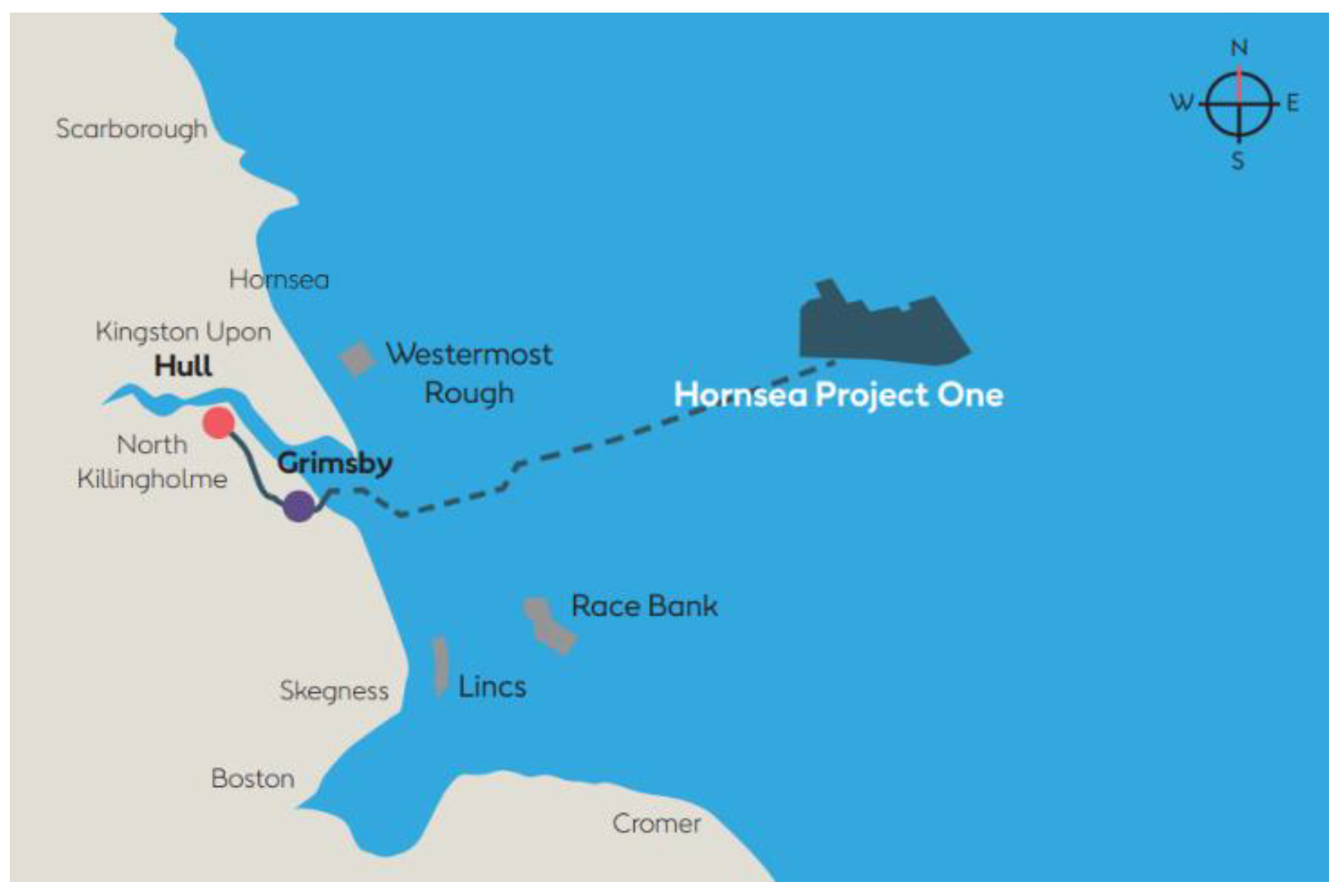

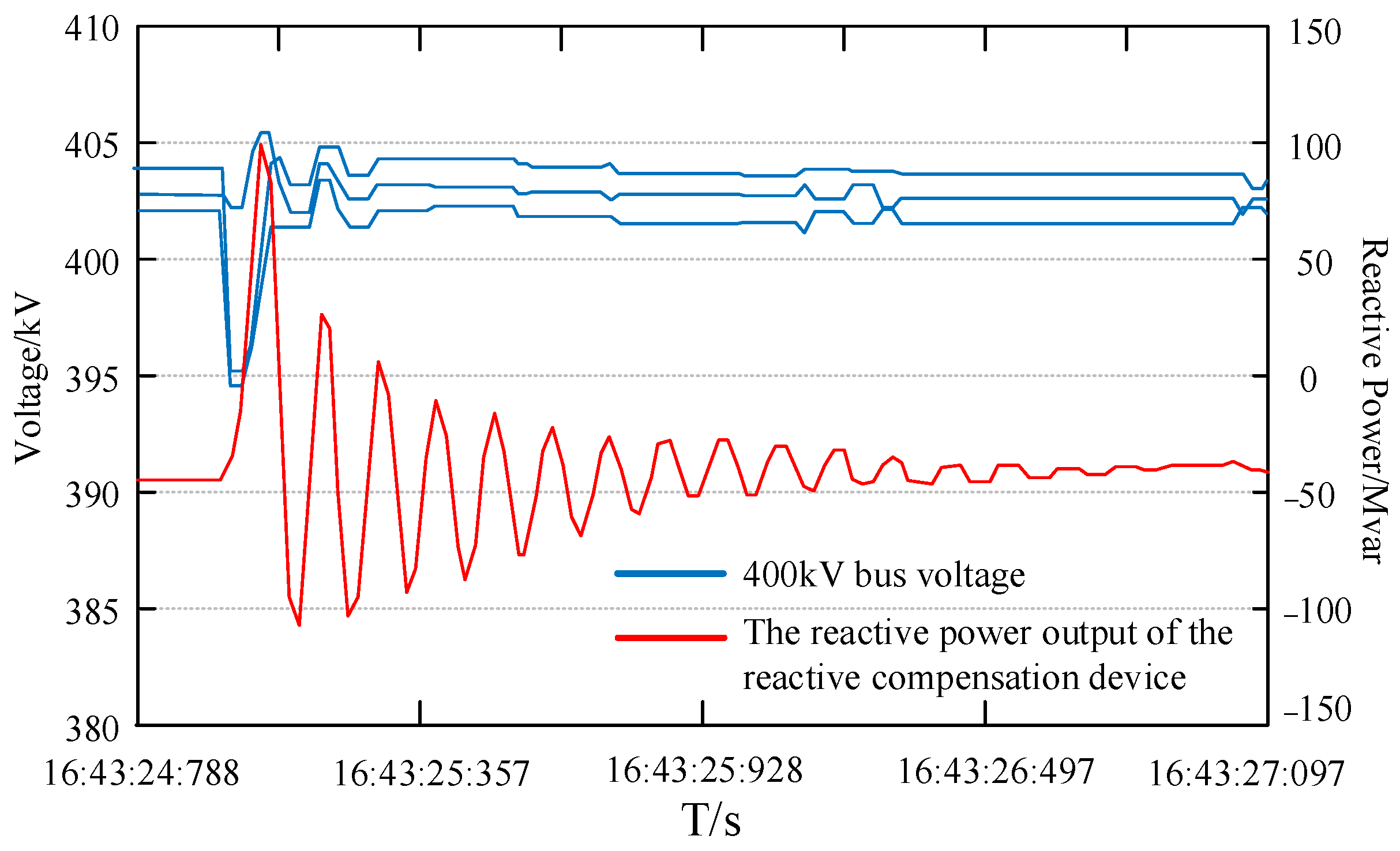

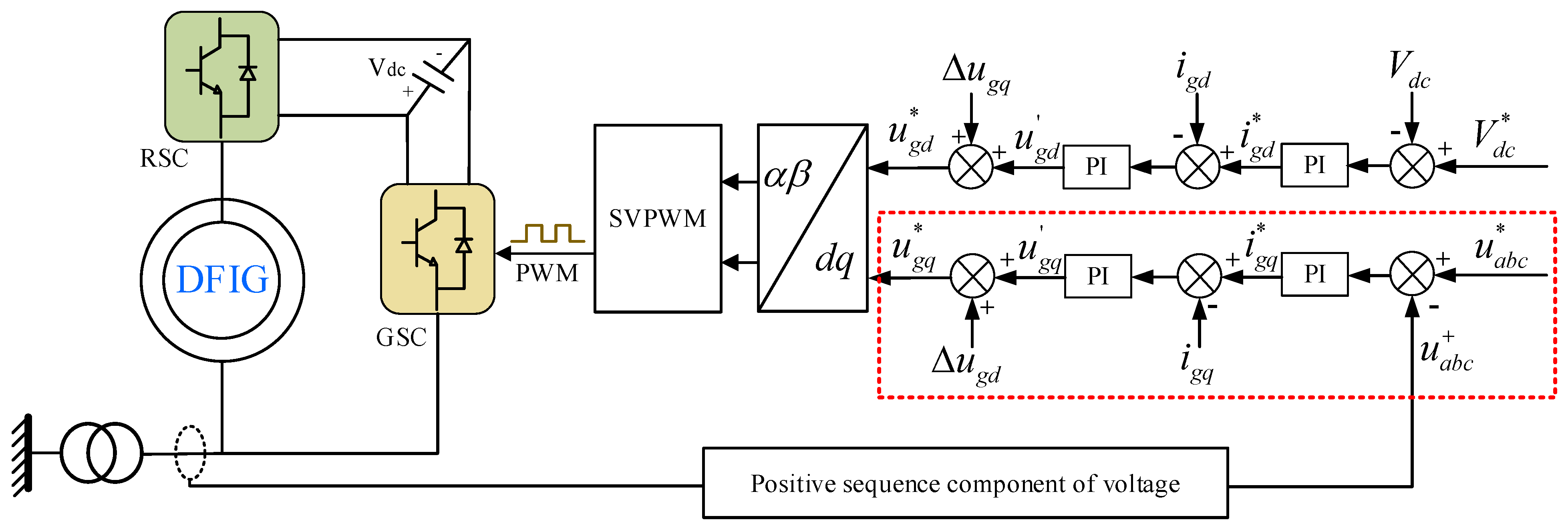

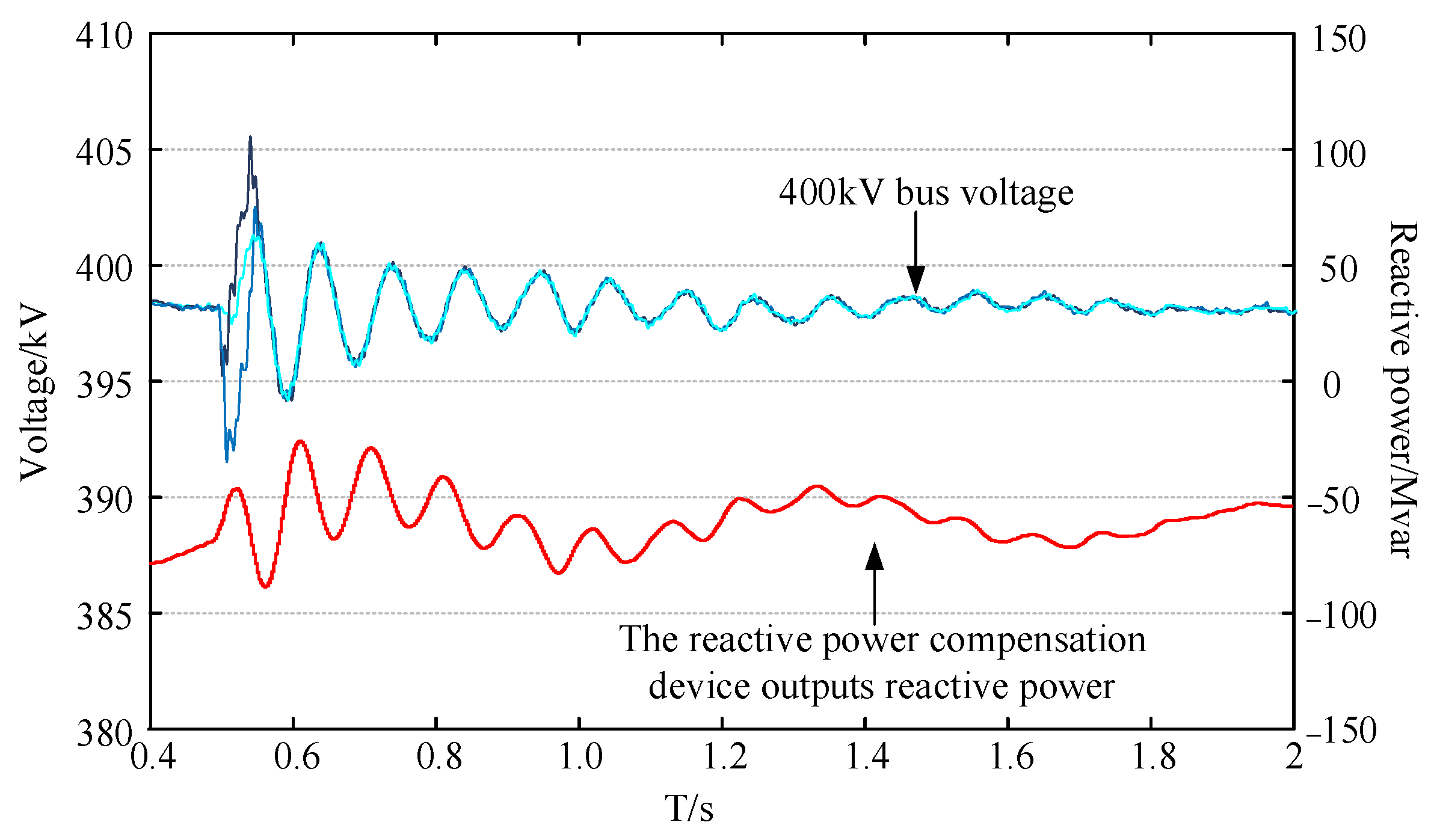
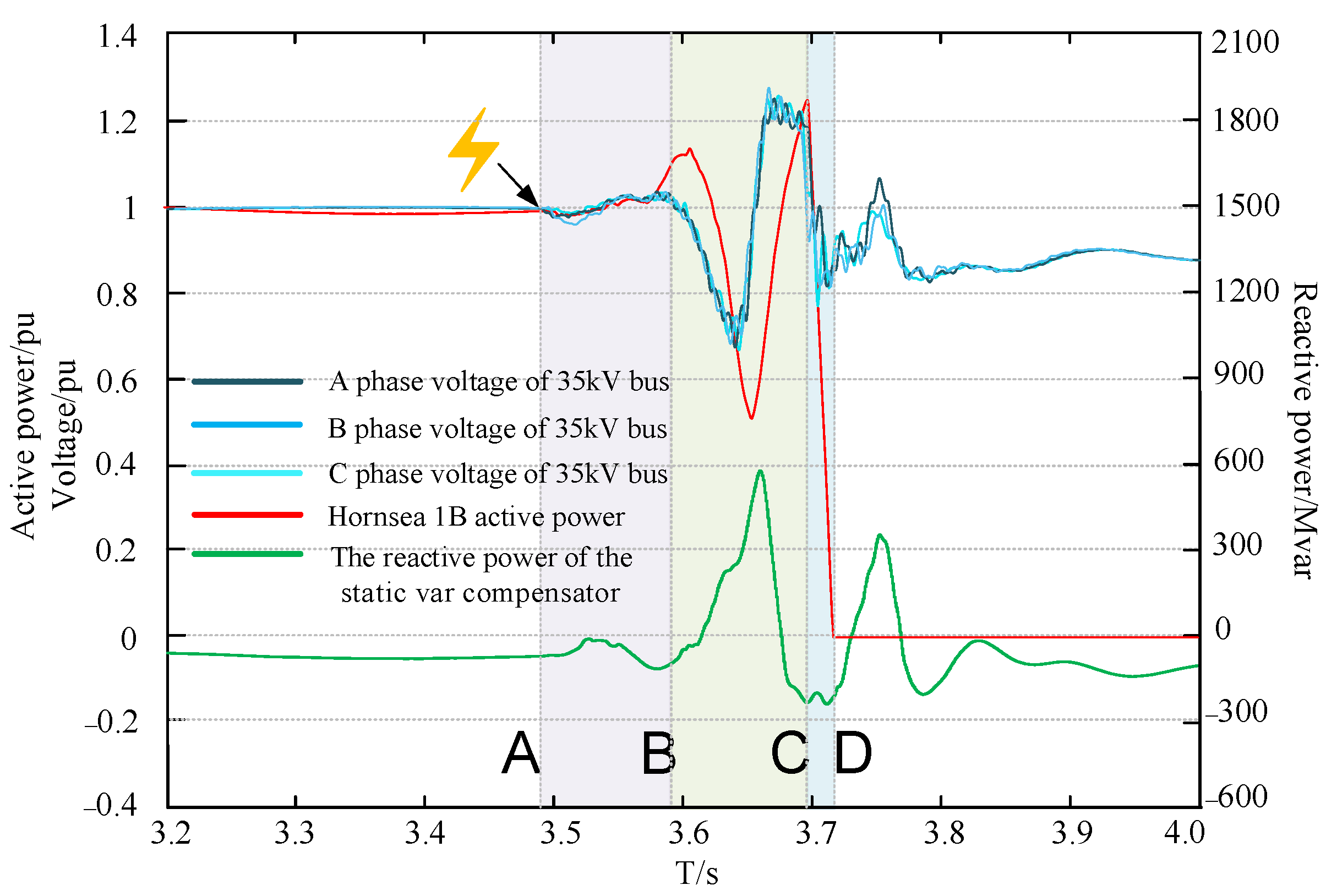
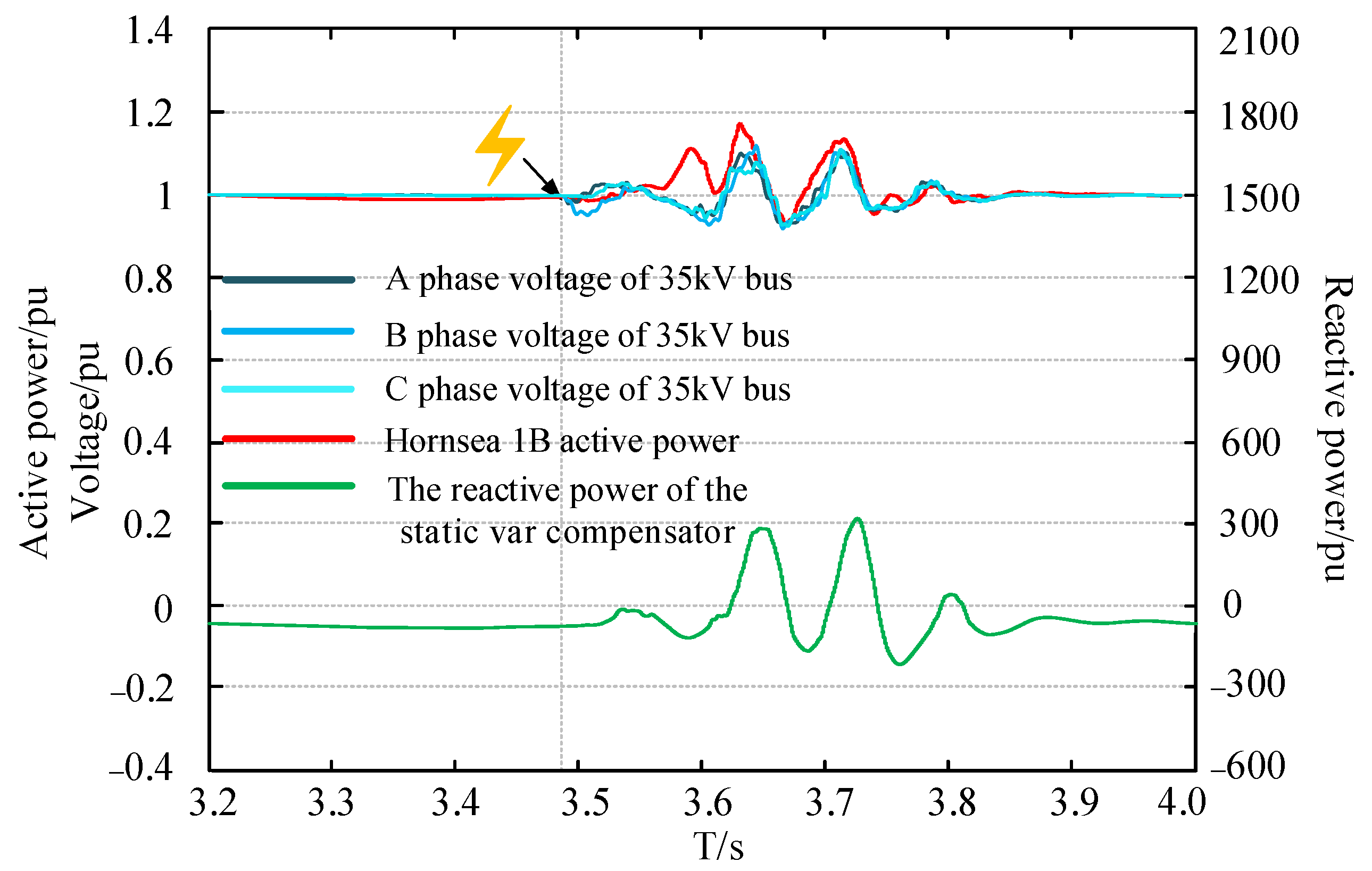
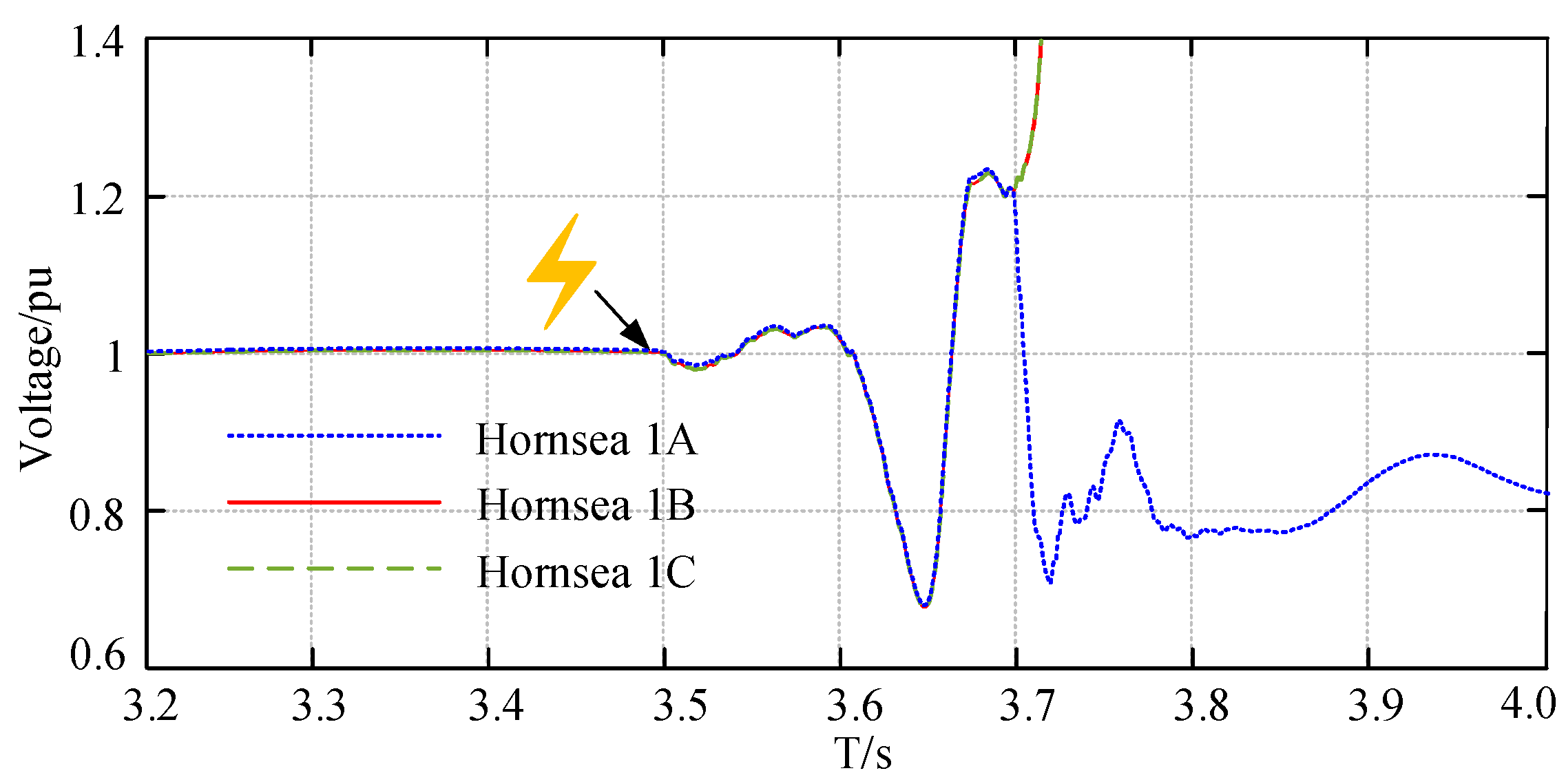

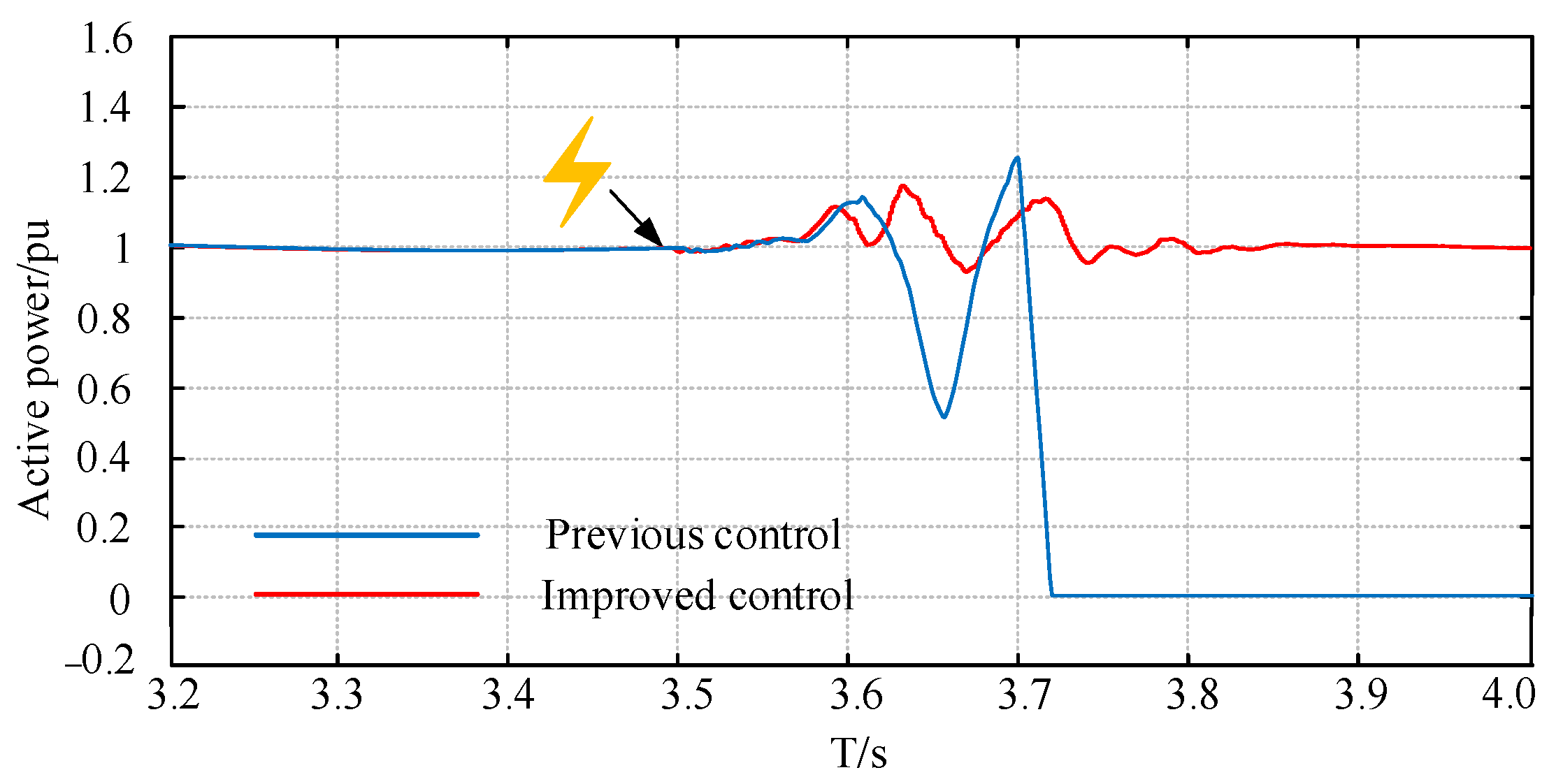
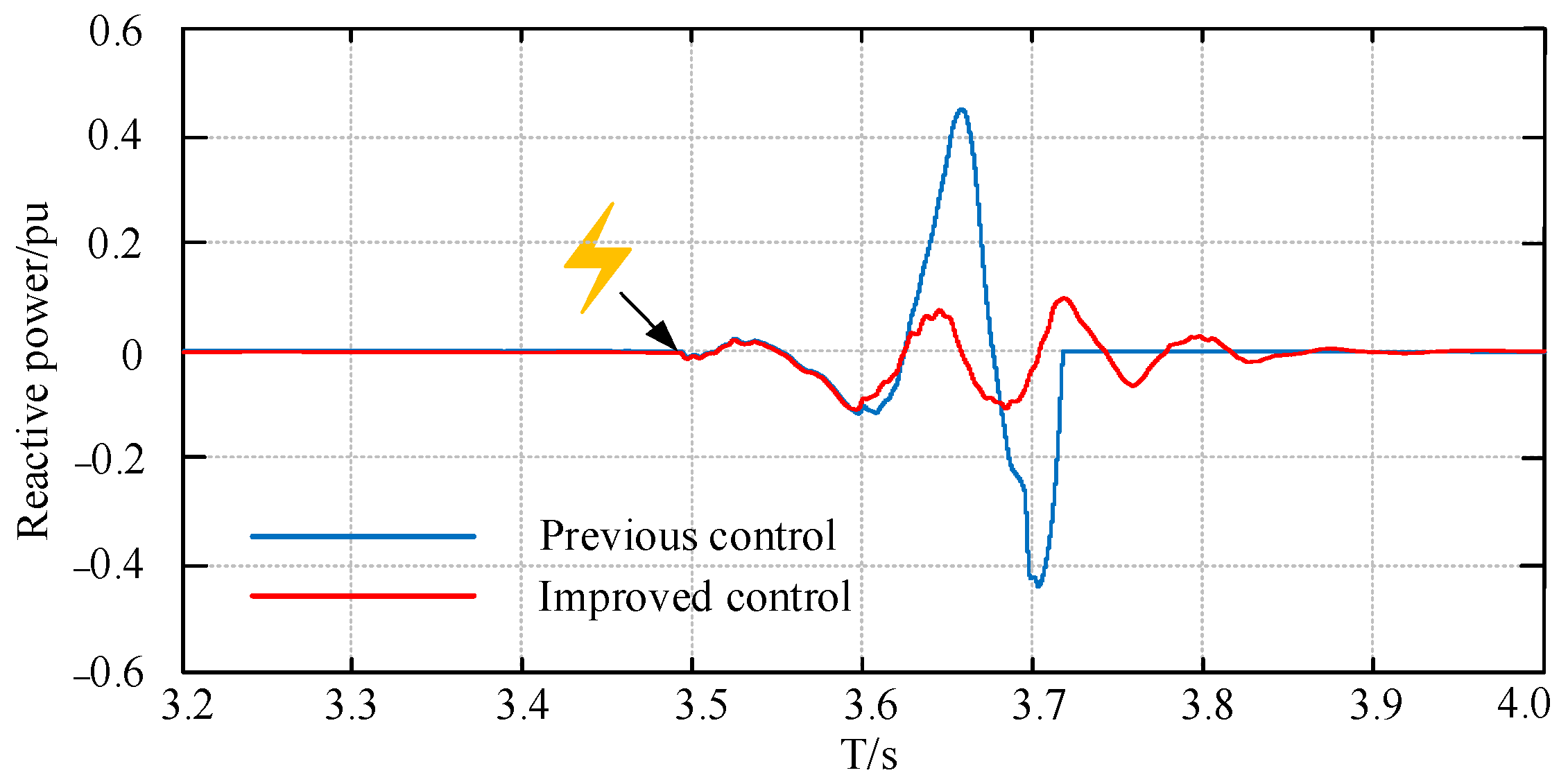
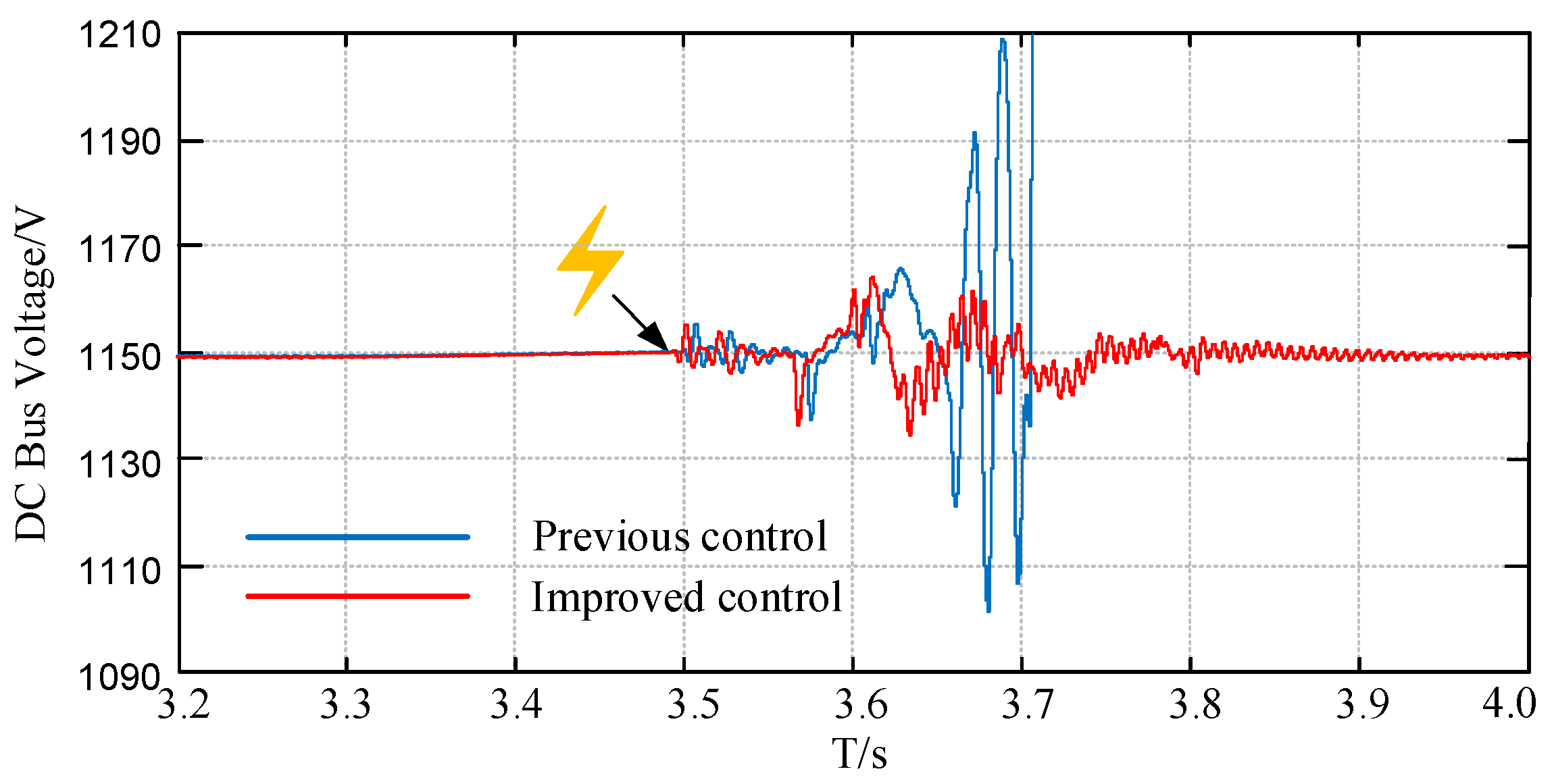
| System Components | Parameters | Value |
|---|---|---|
| Double-Fed Induction Generator | Rated power Pe/(MW) | 1.5 |
| Rated voltage Ue/(V) | 690 | |
| Stator resistance Rs/(pu) | 0.001 | |
| Stator leakage inductance Lsσ/(pu) | 0.8 | |
| Rotor resistance Rr/(pu) | 0.01 | |
| Rotor leakage inductance Lrσ/(pu) | 0.1 | |
| Magnetizing inductance Lm/(pu) | 2.9 | |
| DC bus voltage Vdc/(V) | 1150 | |
| RSC | Proportional coefficient of current regulator Kp_r | 0.55 |
| Integration coefficient of current regulator Ki_r | 8 | |
| GSC | Proportional coefficient of current regulator Kp_g | 0.9 |
| Integration coefficient of current regulator Ki_g | 5 | |
| Proportional coefficient of DC bus voltage regulator Kp_v | 5 | |
| Integration coefficient of DC bus voltage regulator Ki_v | 300 | |
| Transformer | Capacity of main transformer/(MVA) | 1200 |
| Short circuit impedance of main transformer/(pu) | 0.068 | |
| Capacity of box-type transformer/(MVA) | 400 | |
| Short circuit impedance of box-type transformer/(pu) | 0.05 |
Publisher’s Note: MDPI stays neutral with regard to jurisdictional claims in published maps and institutional affiliations. |
© 2021 by the authors. Licensee MDPI, Basel, Switzerland. This article is an open access article distributed under the terms and conditions of the Creative Commons Attribution (CC BY) license (https://creativecommons.org/licenses/by/4.0/).
Share and Cite
Yan, X.; Chang, W.; Cui, S.; Rasool, A.; Jia, J.; Sun, Y. Recurrence of Sub-Synchronous Oscillation Accident of Hornsea Wind Farm in UK and Its Suppression Strategy. Energies 2021, 14, 7685. https://doi.org/10.3390/en14227685
Yan X, Chang W, Cui S, Rasool A, Jia J, Sun Y. Recurrence of Sub-Synchronous Oscillation Accident of Hornsea Wind Farm in UK and Its Suppression Strategy. Energies. 2021; 14(22):7685. https://doi.org/10.3390/en14227685
Chicago/Turabian StyleYan, Xiangwu, Wenfei Chang, Sen Cui, Aazim Rasool, Jiaoxin Jia, and Ying Sun. 2021. "Recurrence of Sub-Synchronous Oscillation Accident of Hornsea Wind Farm in UK and Its Suppression Strategy" Energies 14, no. 22: 7685. https://doi.org/10.3390/en14227685
APA StyleYan, X., Chang, W., Cui, S., Rasool, A., Jia, J., & Sun, Y. (2021). Recurrence of Sub-Synchronous Oscillation Accident of Hornsea Wind Farm in UK and Its Suppression Strategy. Energies, 14(22), 7685. https://doi.org/10.3390/en14227685






